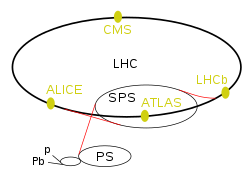 Plan of the LHC experiments and the preaccelerators. | |
| LHC experiments | |
|---|---|
| ATLAS | A Toroidal LHC Apparatus |
| CMS | Compact Muon Solenoid |
| LHCb | LHC-beauty |
| ALICE | A Large Ion Collider Experiment |
| TOTEM | Total Cross Section, Elastic Scattering and Diffraction Dissociation |
| LHCf | LHC-forward |
| MoEDAL | Monopole and Exotics Detector At the LHC |
| FASER | ForwArd Search ExpeRiment |
| SND | Scattering and Neutrino Detector |
| LHC preaccelerators | |
| p and Pb | Linear accelerators for protons (Linac 4) and lead (Linac 3) |
| (not marked) | Proton Synchrotron Booster |
| PS | Proton Synchrotron |
| SPS | Super Proton Synchrotron |
The TOTEM experiment (TOTal Elastic and diffractive cross section Measurement) is one of the nine detector experiments at CERN's Large Hadron Collider. The other eight are: ATLAS, ALICE, CMS, LHCb, LHCf, MoEDAL, FASER and SND@LHC. It shares an interaction point with CMS. The detector aims at measurement of total cross section, elastic scattering, and diffraction processes. The primary instrument of the detector is referred to as a Roman pot. In December 2020, the D0 and TOTEM Collaborations made public the odderon discovery based on a purely data driven approach in a CERN and Fermilab approved preprint that was later published in Physical Review Letters. [1] In this experimental observation, the TOTEM proton-proton data in the region of the diffractive minimum and maximum was extrapolated from 13, 8, 7 and 2.76 TeV to 1.96 TeV and compared this to D0 data at 1.96 TeV in the same t-range giving an odderon significance of 3.4 σ. When combined with TOTEM experimental data at 13 TeV at small scattering angles providing an odderon significance of 3.4 - 4.6 σ, the combination resulted in an odderon significance of at least 5.2 σ. [2]

